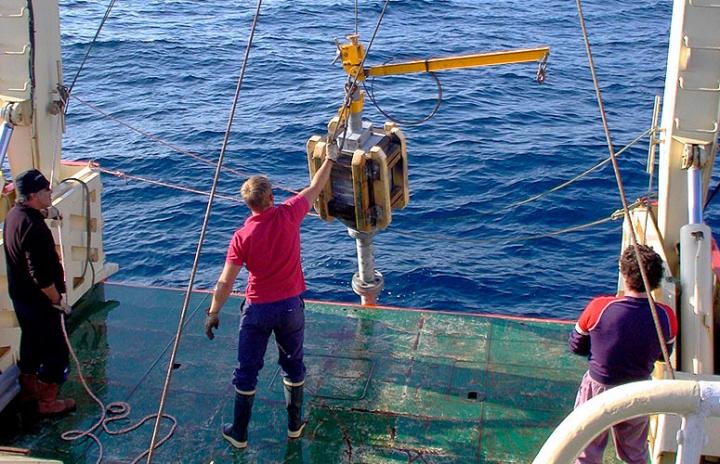A study by the University of the Basque Country (UPV/EHU) provides a detailed description of the climate changes taking place in the Bay of Biscay over the last 37,000 years

Credit: Julio Rodríguez-UPV/EHU
The climate represents the set of atmospheric conditions that characterize a region. Yet these conditions are the result of global interaction between dry land, vegetation, ice, atmosphere and ocean. “Bearing in mind that the oceans cover 75% of the earth’s surface, the influence they exert on the climate is very strong, and conversely, the oceans are strongly influenced by climate changes. In our group we are involved in the study of palaeoceanography in which we seek and analyse evidence on how the ocean has changed during various climatic periods or intervals. Our study focusses on the Bay of Biscay, a part of the ocean we have off our coasts,” said Julio Rodríguez-Lázaro, professor of the Department of Stratigraphy and Palaeontology at the UPV/EHU’s Faculty of Science and Technology and one of the authors of the study.
In a piece of work recently published in the Quaternary International journal, this group mainly comprising female researchers detailed with great precision many of the climatic events occurring in the last 37,000 years. To do this they resorted to the study of the microfossils of 176 species of benthic foraminifera obtained from cores of the ocean floor. The foraminifera studied are tiny marine organisms (a single, but very large cell), characterised by a carbonate shell the size of a grain of sand widely used in palaeoceanography because “we can find out the conditions prevailing in a specific location and during a specific period in terms of the species that are plentiful in one geological epoch or another. This faunal analysis is possible because many of the foraminifera species are highly sensitive to basic environmental parameters, such as temperature, oxygen concentration or organic matter content,” said the researcher.
So in the sediment of the Bay of Biscay they were able to identify evidence of known climatic episodes, not only cold periods, such as the Younger Dryas or Heinrich events, but also warm intervals, such as the Bolling-Allerod or the Holocene, occurring throughout recent geological history, including recent millennia. In addition, they regard the identification of the 176 benthic foraminifera described as “a contribution towards knowledge about the biodiversity existing in the Bay of Biscay during the Quaternary period”.
Involvement of oceans in global climate
Beyond the last 37,000 years the research group in the UPV/EHU’s Department of Stratigraphy and Palaeontology is working on detecting the climate changes that took place in the Bay of Biscay 150,000 years ago. Rodriguez sums it up thus: “The climate on the planet during this period of time is characterised by the sharp alternation of warm and cool periods, and these climate changes appear to have taken place about every 1,500 years. Warming (up to 10 ºC) takes place within a few decades while cooling occurs over the course of several centuries. When cooling occurs, what happens is that the water in the north Atlantic Ocean cools down coinciding with massive iceberg discharges originating from the breaking up of ice sheets in the Arctic Ocean, and the result is a cool climate period in the northern hemisphere.”
These rapid climate changes are caused by alterations in the so-called AMOC (Atlantic Meridional Overturning Circulation); this is when heat is carried northwards from the south Atlantic by the movements of ocean water bodies, where warm, less dense tropical waters move northwards, while cold, denser waters of the north Atlantic head southwards at a depth. On their way these water movements modify not only the climate of Europe (making it milder), but also that of the planet as a whole. AMOC is altered when not very salty waters head into the Arctic owing to the melting of permafrost and also as a result of changes caused by the thickness of the ice in these Arctic latitudes.
The geological moment we are experiencing right now is an interglacial “or warm” (Holocene) epoch, and “if we were progressing at the rate at which previous intervals of cold and heat took place, we should be moving towards a cooling down, but this is not happening,” warned Rodriguez. “As a result of human activity, we are altering this cycle, we are modifying the natural balance. And that could have serious consequences during the forthcoming climate cycles in the near future”.
###
Media Contact
Matxalen Sotillo
[email protected]
Related Journal Article
http://dx.




